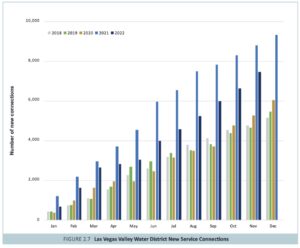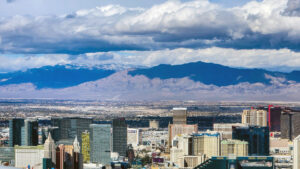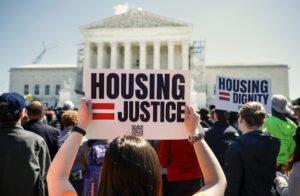5:00
News Story
Lombardo’s desire for public land sales could boost warehouse economy
Hidden Valley in the McCullough Range south of Henderson and east of I-80 is in one the largest “disposal areas” in a federal lands bill backed by Nevada officials. (Photo: Kyle Roerink)
Hidden Valley in the McCullough Range south of Henderson and east of I-80 is in one the largest “disposal areas” in a federal lands bill backed by Nevada officials. (Photo: Kyle Roerink)
Gov. Joe Lombardo’s support for the sale of federal lands to developers would increase the state’s economic resilience and decrease its reliance on tourism, say proponents. It would also likely cement Southern Nevada’s place in the warehouse boom.
“I would like to see us, in coordination with our congressional delegation, promote a more predictable approach to the timely release of federal lands,” Lombardo said in his State of the State address last month. “The disposition of federally managed lands within, and adjacent to, city and county boundaries is a critical component to economic development and affordable housing.”
But with mortgage interest rates depressing new home sales, demand for residential land is down.
“Prices have gone up so dramatically. So there’s a little bit of hesitancy with builders,” says land consultant John Restrepo. “The strongest demand is for industrial.”
Restrepo says the hoopla that accompanied once-raucous federal land auctions has dissipated, in part because parcels are often subpar in terms of location, size, access, and infrastructure.
In 2020, Restrepo identified 19,088 acres in 198 parcels of “potentially developable employment land” in the Las Vegas Valley, including federally-owned parcels that had not been released under the Southern Nevada Public Land Management Act of 1998 (SNPLMA).
First lady stands to profit from warehouse economy
The release of more federal lands, especially for industrial use, could prove a financial boon to the Lombardo family.
First Lady Donna Alderson is a longtime commercial real estate broker “focusing solely on the sales and leasing of industrial properties,” according to the Cushman & Wakefield website.
In 2021 and 2022 combined, Alderson represented parties in sales and leases totaling more than $300 million, according to a list of transactions on the website, which has been removed in recent days. Her most recent deal, a lease valued at $4.5 million, closed on Jan 2, a day after her husband took office as governor.
Commercial brokers generally earn a commission between 4% and 8%, according to industry experts.
The First Lady did not respond to requests for an interview and Lombardo’s spokeswoman did not respond to questions about the governor’s obligation to avoid the perception of a conflict of interest.
Lombardo’s campaign ran ads claiming then-Gov. Steve Sisolak’s wife, Kathy Sisolak, was profiting from a contract with the state. Kathy Sisolak’s business partner, Guy Hobbs, says Sisolak’s wife had no involvement with the firm’s state work.
Dr. Abigail Aguilar of UNLV’s Department of Philosophy says expecting a public official’s partner to avoid areas that fall under the official’s duties is “too high a standard” in an age when both partners generally work.
The key, Aguilar says, is transparency.
“Otherwise, the public loses trust in the system due to suspicion that officials are taking advantage of their positions, and we know how detrimental it is when the public no longer trusts its institutions,” she says.
Instead, systems should be in place to prevent preferential treatment, including full access to relevant information so the public “can hold public officials accountable if they have unfairly benefitted from their positions or even seem to have done so.”
“The preferred land is pretty much all gone, particularly in the Las Vegas Valley and in the urbanized portion of Clark County,” Restrepo said in an interview. “Everyone’s waiting for the lands bill.”
The lands bill, also known as the Southern Nevada Economic Development and Conservation Act (SNEDCA), was introduced by U.S. Sen. Catherine Cortez Masto, a Democrat, in 2021 and stalled in the last session of Congress. It would make 42,427 acres of federal land – approximately 65 square miles south of the valley – available for sale and development.
Cortez Masto’s office did not respond to inquiries about the bill’s chances in the current Congress.
The proceeds from federal land sales are intended under current federal law to be used to purchase environmentally sensitive lands and to fund the removal of hazardous trees and brush in areas such as Lake Tahoe.
SNEDCA seeks to sate the appetites of developers while winning the support of conservationists by setting aside 2 million acres of environmentally sensitive lands in the Red Rock Canyon National Conservation Area and Desert National Wildlife Refuge.
A spokeswoman for Lombardo says the governor “looks forward to working with all members of the Nevada delegation as the Southern Nevada Economic Development and Conservation Act makes its way through Congress.”
Nevada’s only Republican congressional delegate, Rep. Mark Amodei, introduced sweeping legislation in 2015 requiring the federal government to dispose of millions of acres of federal land inNevada. That bill died after a single hearing.
“Transferring millions of acres of public lands … is not something I think the majority of people think is a good idea,” Amodei said during a 2017 interview with the Reno Gazette-Journal editorial board.
More recently, Amodei and Cortez Masto shepherded a provision into the Defense Authorization Act at the end of last year. The main thrust of the provision granted 600,000 acres of federal land to nearly triple the size of a Naval air station bombing range near Fallon. But the legislation also opens thousands of acres of public land for development in Churchill and Lander counties.
“This land is your land…”
Environmental groups are bitterly divided over the sale of public lands to developers.
Supporters, such as the Nevada Conservation League, tout the benefits of preserving swaths of sensitive lands while adding to the housing stock.
Critics say SNEDCA is green-washing – a pro-development proposal under the guise of environmentalism. They caution it will fuel sprawl and its accompanying ills, destroy wildlife habitat, and exacerbate the water crisis.
Lombardo, in his State of the State speech, identified the water crisis as the greatest challenge facing the state.
“Southern Nevada’s unique ability to capture, treat and return water to the Colorado River is a clear competitive advantage, but our future is dependent on our ability to conserve and prioritize our use of water,” Lombardo said.
Kyle Roerink of the Great Basin Water Network agrees with Lombardo that perpetual recycling is not a viable plan. But he says adding a metropolitan area the size of Miami does nothing for conservation.
While running for governor, Lombardo said in a debate that local governments should not restrict the use of federal lands.
 “Lombardo is following the grand old Nevada tradition of wanting to hand over our public lands to real estate developers who are salivating at the opportunity of getting more cheap land that they can profit off of,” Roerink said, pointing to a Southern Nevada Water Authority chart illustrating new service connections.
“Lombardo is following the grand old Nevada tradition of wanting to hand over our public lands to real estate developers who are salivating at the opportunity of getting more cheap land that they can profit off of,” Roerink said, pointing to a Southern Nevada Water Authority chart illustrating new service connections.
“It disregards our future water supply. It disregards emissions, vehicle miles traveled,” Roerink says. “We don’t talk about the cost of roads leading to new subdivisions or shopping malls over the course of 50 to 100 years. Developers do pay on the front end, but after that, everything is predicated on expanding the tax base.”
Business suburb of L.A.
While office space and residential sectors have softened, demand remains strong for industrial space, says Restrepo, driven in part by demand from California, where the warehouse boom is reshaping California’s Inland Empire from farming to industrial, the Los Angeles Times reported this week.
“California is a major driver to the health and resilience of our economy, not only in terms of visitors, but also in terms of us becoming, in many ways, a business suburb of Los Angeles,” he says. Planting more warehouses in the Mojave Desert would produce better-paying jobs and integrate the economy “so we’re more closely aligned toward California’s needs.”
The vacancy rate for industrial space in Las Vegas in the fourth quarter of 2022 was 2.1%, compared to 11.6% for office space, according to Newmark, a global real estate service company.
Ivanpah, the airport planned near the California state line to relieve traffic when Reid International is maxed out, “is slated to have 15,000 acres for what they call ancillary supportive uses to the airport,” says Restrepo. “That would be warehouse distribution, logistics, and commercial development.”
Our stories may be republished online or in print under Creative Commons license CC BY-NC-ND 4.0. We ask that you edit only for style or to shorten, provide proper attribution and link to our website. AP and Getty images may not be republished. Please see our republishing guidelines for use of any other photos and graphics.



